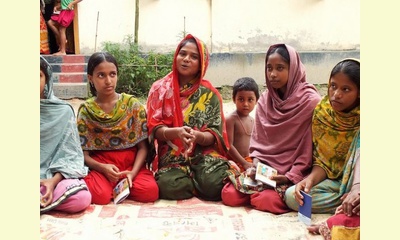|
|
Bangladeshi Girls Seek Equal Opportunity
un article par Inter Press Service (reprinted by permission) (abridged)
Until five years ago, Shima Aktar, a student in Gajaghanta village in
the Rangpur district of Bangladesh, about 370 km northwest of the
capital Dhaka, was leading a normal life. But when her father
decided that it was time for her to conform to purdah, a religious
practice of female seclusion, things changed. The young girl, now
16 years old, says her father pulled her out of school at the age of
11 and began to lay plans for her marriage to an older man “for her
own protection” he said. 
Adolescent girls in Bangladesh’s Mymensingh district meet once a week to discuss their rights. Here they talk about sanitation and personal hygiene. Credit: Naimul Haq/IPS
click on photo to enlarge
Born to a hardline Muslim family, pretty, shy Shima might have
taken these changes in stride – were it not for the support of a local
youth advocacy group.
Called ‘Kishori Abhijan’, meaning ‘Empowering Adolescents’, the
project is a brainchild of the United Nations Children’s Fund
(UNICEF) and educates young people on a range of issues, from
gender roles, sex discrimination and early marriage, to reproductive
health, personal hygiene and preventing child labour.
Now that she knows her rights, Shima is fighting hard to assert
them, joining a veritable army of young women around this country
of 160 million who are determined to change traditional views
about gender.
Besides the Empowering Adolescents initiative, other grassroots
schemes to educate communities on the rights of women include
groups that practice interactive popular theatre (IPT), designed to
address social issues at a local level.
Using a mix of popular folk tales and traditional songs and dancing,
the actors perform for their parents, local officials and other
influential community members, determined to have their voices
heard by breaking out of the box.
The Centre for Mass Education in Science (CMES), an NGO working
in a remote part of the Rangpur district, recently put on a public
performance to illustrate the need to abolish the dowry system, and
boost female participation in the public workforce.
Thousands of women here live under the shadow of dowry-related
violence. . . The year 2011 saw 330 deaths of women in dowry-
related violence. The previous year 137 women were killed for the
same reason, according to the largest women’s rights NGO,
Bangladesh Mahila Parishad. The NGO also reported 439 cases of
dowry-related violence in 2013. . . .
In 1994 the government introduced the Female Secondary School
Stipend Programme – funded by the World Bank, the Asian
Development Bank (ADB) and the Norwegian government – that
offered adolescent girls a small amount of money every six months
to stay in school.
Although urban and rural disparities still exist, the average primary
school enrollment rate for girls is now as high as 97 percent, one of
the highest in the developing world.
The field of reproductive health and rights has also witnessed
improvements. The presence of skilled birth attendants in rural
areas has increased from less than five percent in the early 90s to
23 percent today, while contraceptive use among women has
dramatically increased from a mere eight percent in 1975 to about
62 percent in 2011.
Despite these achievements, girls still lag behind their male
counterparts throughout much of the country.
[Thank you to Janet Hudgins, the CPNN reporter for this article.]
|








|
DISCUSSION
Question(s) liée(s) à cet article:
What other resources can be utilized to give women more opportunities?,
* * * * *
Commentaire le plus récent:
On their website, the United Nations Population Fund makes it clear that lack of access to family planning is a form of violence against women.
"Gender-based violence both reflects and reinforces inequities between men and women and compromises the health, dignity, security and autonomy of its victims. It encompasses a wide range of human rights violations, including sexual abuse of children, rape, domestic violence, sexual assault and harassment, trafficking of women and girls and several harmful traditional practices. Any one of these abuses can leave deep psychological scars, damage the health of women and girls in general, including their reproductive and sexual health, and in some instances, results in death.
Violence against women has been called "the most pervasive yet least recognized human rights abuse in the world." Accordingly, the Vienna Human Rights Conference and the Fourth World Conference on Women gave priority to this issue, which jeopardizes women's lives, bodies, psychological integrity and freedom. Violence may have profound effects – direct and indirect – on a woman's reproductive health, including:
Unwanted pregnancies and restricted access to family planning information and contraceptives
Unsafe abortion or injuries sustained during a legal abortion after an unwanted pregnancy
Complications from frequent, high-risk pregnancies and lack of follow-up care
Sexually transmitted infections, including HIV
Persistent gynaecological problems
Psychological problems
Gender-based violence also serves – by intention or effect – to perpetuate male power and control. It is sustained by a culture of silence and denial of the seriousness of the health consequences of abuse. In addition to the harm they exact on the individual level, these consequences also exact a social toll and place a heavy and unnecessary burden on health services.
UNFPA recognizes that violence against women is inextricably linked to gender-based inequalities. When women and girls are expected to be generally subservient, their behaviour in relation to their health, including reproductive health, is negatively affected at all stages of the life cycle.
UNFPA puts every effort into breaking the silence and ensuring that the voices of women are heard. At the same time, the Fund works to change the paradigm of masculinity that allows for the resolution of conflict through violence. . ... continuation.

|
|









